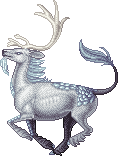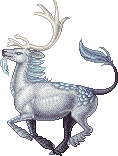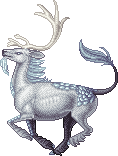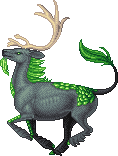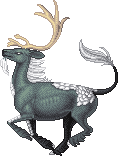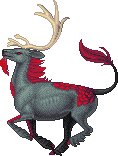Ageti Forest Research Center
Office Suite no. 03
Dearest Mahmoun,
I hope that you have had a pleasant and temperate winter and that the Great Tagg River has flowed abundantly and in fair favor as you move into planting season. I wish to express my gratitude for allowing me to accompany you and your laboratory group on the expedition to Tetzcotal. I learned a great deal from you and your colleagues, research that I eagerly transmitted to my associates here at the Keep. As you know, we have long maintained a mutually beneficial relationship with the Farir, the gardens and surrounding forestland serving for their nourishment and ours.
Farir reproduce prolifically, both during their annual forest ceremonies and during intermittent periods in the interim. The colorific offspring resulting from these unions have been well documented — indeed, the understated beauty of long walks in the forests initially inspired my foray into this realm of magic research. Of course, you well know this. After all, it was only mere years ago that you identified the Hazel Farir as a distinct color variant with its own unique relationships to other Farir varietals, a groundbreaking finding.
The discussions that I shared with you and your lab group, especially the young magi Elwy and Imra, inspired the research document that I am enclosing along with the well wishes in this letter. As you may have heard (forgive me, I know not whether the news traveled to Ageti), High Archmage Thane and Lady Alua have called a research symposium regarding the breeding habits of the various creatures of the world. So, I wish to reiterate my gratitude for your support of my nascent research career, and I hope that you find the results of this research fruitful and, at the very least, interesting.
Please send my sincere thanks to Orndeh and Chand for hosting me in Ageti, and to Janeena for the wonderful dining recommendations during my stay. I hope to return soon.
Warmest regards,
Crazyflight
|||||||||||||||||||||||||||||||||||||||||||||||||||||||||||||||||||||||||||||||||||||||||||||||||||||||||||||||||||||||||||||||||||||||||||||||||||||||||||||||||||||||||||||||||||||||||
Introduction
Farir may be small and insignificant to the naked eye, but a closer look reveals one of the most marvelous creatures of our world, life forms that themselves are lifeways, much more than simply individual creatures but indeed reflections of entire multi-kingdom pathways that unite humans, animals, creatures, plants, and, of course, magic. Farir allow forests and other green environments to flourish and heal the diverse denizens of the Keep and beyond with powerful magic. Importantly, Farir serve as crucial indicators of the health of forest environments, as the Ageti Forest Research Center found recently following a series of expeditions in and surrounding the Ixan Jungle, one of which I had the immense privilege of joining.
Magi of the Keep are well aware of the color variations that manifest within Farir populations. These patterns often resemble the spectrum of brilliant leaf colorations one can find in our forestland environs. Farir always have been, naturally, intimately connected to the elemental magic of life and therefore to the intangible and unknowable life forces that make up this natural environment, so it is no wonder that this co-developmental camouflage can be observed. The breathtaking beauty that Farir bring to the forestlands are brilliant in their own right; this paper propounds that these color variations are also indispensable phenomena for understanding the mysteries of life magic that the Keep's scholars, led by High Archmage Thane and the illustrious Lady Alua, are on the verge of ascertaining.
To this end, for the following paper I have harnessed my multidisciplinary expertise — which involves various hybrid studies that include the gentle Cervinus Deer, magnificent Gemstone Kirin, and majestic Psittarx Dragons — and years of research and collection of Farir varietals, to each of whom I owe the sincerest thanks. In terms of acknowledgments, I would be remiss if I did not mention Archmage Mahmoun and his stupendous laboratory at the Ageti Forest Research Center.
Finally, this paper is dedicated to dewy mornings, twigs snapping underfoot, damp, earthy fragrances, fungi and lichens, and leafpiles, beautiful assemblages of leaves.
Research premise and questions for careful consideration
This paper does not seek to solve the mystery of how Farir bring about new life in their annual forest ceremonies. Some phenomena are better left as mysteries; it would be grand to assume that we can "know" these intimacies of the natural world with any level of precision. The scope of this analysis is limited to the forms of reproduction that Farir display periodically and at unpredictable intervals during any given season. Based on anecdotal evidence, these are the breeding rituals that bring about color variations, while it is speculated that the annual gatherings bring about new Green Farir life from magic.
Given this constraint, this paper seeks to approach an understanding of under what circumstances Farir breeding results in color variations. In addition, this paper uses data collected over the past several years to answer the question of how often Farir breedings result in hybrid variations compared to other results. By taking a naturally curious approach to the manipulation of life magic that Farir display, this study also dutifully records related factors pertaining to this magical affinity and postulates potential causes and effects, including but not limited to love, monogamy, and other interpersonal (or interfaririal) conditions, as well as other exogenous factors such as weather, forest health, etc.
Description of sample and data collected
This study relies on breeding data collected irregularly over a span of thirteen years.
The environment presently involves 40 male/female pairs of Green Farir, 46 Yellow Farir, and 30 Golden Farir. However, I must note that especially in the days of my earliest studies, there were ten Farir pairs that no longer belong to my keep — although I have maintained records of those breeding results from these studies, my ability to glean qualitative results from these data is limited. I ultimately made the decision to include these breeding results, though, to bolster the sample's statistical significance. The vast majority of the data analyzed pertain to the Farir that are presently part of my keep environment.
Green Farir are described in pairs as followed henceforth because of their observable natural affinity toward monogamy and companionship. [As a minor digression, this behavior among Green Farir was encouraged by naming and spatial placement conditions within their environment. Admittedly, with the lack of a control factor, the impact of these conditions on their tendency toward monogamy is impossible to quantify.]
All hybrid varietals (Yellow, Golden, and Orange Farir) studied, on the other hand, were permitted and encouraged to breed freely with other Farir within the environment, hence the irregularities in terms of gender ratio and breeding patterns. Key caveats to this effect are expounded upon in below sections of this paper. All Yellow and Golden Farir studied here are offspring of the Green Farir pairs, all of which in turn have their origins in the Stream. Orange Farir produced as a result of some breeding attempts between Golden Farir were not studied because of their demonstrated inability to produce a subsequent new hybrid varietal (although this is an area for potential novel research in Farir breeding patterns).
Additionally, it is worth noting that due to the vicissitudes of breeding patterns, environmental changes, and research funding (again I feel compelled to heartily thank High Archmage Thane for his generous patronage of investigative matters at the Keep), the number of Farir listed presently is current as of the writing of this paper — thirteen years ago, my studies began with a mere three pairs of Farir.
The aforementioned breeding data classify breeding results as follows:
- Failure: any attempt that for various reasons, including disinterest or otherwise, did not result in an egg;
- Non-hybrid: any attempt resulting in an egg of the same varietal of the parents;
- Hybrid: any attempt resulting in an egg of the subsequent hybrid varietal pattern (green > Yellow > Golden > Orange).
[For those interested in a survey of such research, Archmage Mahmoun et al. conducted studies to this effect, including results proving that the Hazel Farir varietal is also able to breed with all Farir varietals, although this will never result in an "advanced" hybrid varietal. Such results can be compared with the breeding behaviors of Emerald and Sacelle Crested Psittarx Dragons, who are able to cross-breed. Like many other similar interspecies pairing, these breeding attempts can result in either of the parent species — or, in contrast to the Farir, may result in an advanced hybrid of the Crested Psittarx Dragon, either Lapis or Levante.]
Quantitative results
The sample utilized in this study comprises 1,097 total breeding attempts. Of these attempts, 448 pertain to Green Farir pairs; 275 pertain to Yellow Farir pairs; and 374 pertain to Golden Farir pairs.
[Note of interest: This sample may seem irregular given the relative sample size of each varietal. Admittedly, much of the breeding attempts involving hybrid varietals were carried out with the intent to sell (to raise funds for future research, of obvious course) or gift a rare hybrid varietal (especially Orange Farir) to a deserving magi. This note serves to clarify the imbalances implicit to the sample, but also to caveat that any analysis of Farir breeding behavior presented henceforth includes careful consideration of the cases in which breeding attempts were undertaken intentionally versus in a purely natural setting.]
Green Farir breeding results
Of the 448 breeding attempts recorded during the duration of the study, the following results were observed:
- Failure: 279 (62.28%)
- Non-hybrid: 107 (23.88%)
- Hybrid: 62 (13.84%)
Of the 275 breeding attempts recorded during the duration of the study, the following results were observed:
- Failure: 156 (56.73%)
- Non-hybrid: 54 (19.64%)
- Hybrid: 65 (23.64%)
Of the 374 breeding attempts recorded during the duration of the study, the following results were observed:
- Failure: 237 (63.37%)
- Non-hybrid: 82 (21.93%)
- Hybrid: 55 (14.71%)
According to the above results, it is substantively easier for Yellow Farir varietals to produce Golden Farir hybrids than for other varietals to produce their respective hybrid varietals than other breeding variations. Other breeding patterns (Green to Yellow and Golden to Orange, to simplify) display strikingly similar ratios of failure, non-hybrid, and hybrid results, implying that achieving a hybrid breed attempt outcome is easier for Yellow Farir varietals. Additionally, the rates of general failure are statistically-significantly lower for Yellow Farir breeding among themselves than for other varietal intra-breeding combinations. Even so, for all breeding attempts, the rates of failure were consistently above 50%, implying difficulties in hybrid color projects across different varietals.
Case studies and qualitative observations
Aside from the general results observed from the generalized sample of breeding data from over the preceding decade, I have compiled the following case studies, including qualitative results, from my casual observation of the Farir under my supervision. I humbly propound that these results hold deeper implications for our collective understanding of the Farir species, and therefore of hybrid breeding projects generally, than the quantitative results enumerated above. Numbers and statistics certainly prove useful, but the study of magic requires a multidisciplinary approach that cannot barely solely on crunching numbers.
Firstly, I have observed considerable affinities among particular cases of both Green and Yellow Farir pairs, consequently resulting in noteworthy offspring/familial relationships within the observed population.
For example, although the hybrid breed rate among Green Farir sits at 13.84%, a few pairs (only pairs with more than five breeding attempts were considered within this cohort) demonstrated rates of hybrid offspring production well above average: 2096026 and 1996323 (50%); 1704672 and 1846691 (43%); 2222110 and 2037061 (33%); 5532053 and 8202207 (29%); 1955387 and 1829674 (29%).
The aforementioned Green Farir pairs — although it is worth reiterating that all Green Farir pairs were intentionally kept in pairs upon being introduced — displayed considerably more profound interfaririal relations than other pairs, including increased physical intimacy and heightened awareness of forest-related concerns. These results, coupled with their considerable hybrid varietal breeding likelihoods, imply that some pairs of Farir are greater disposed to alignment with life magic than others. Furthermore, attunement with life magic is naturally predicated upon the successful union of two individuals with an existing affinity for one another, which presents profound implications for the influence of factors relating to love and intimacy on life magic attunement among green Farir. In other words, a pair of Farir, in magical terms, is greater than simply two Farir.
Furthermore, some Yellow Farir pairs also demonstrated considerable affinity in terms of hybrid varietal production, which may present even more profound implications for the relationship between interfaririal relationships and life magic attunement, given that Yellow Farir pairs were never encouraged toward monogamy, and instead were always presented with free breeding options within the environment.
- Yellow Farir 8234646 participated in 16 total breeding attempts with nine different other Yellow Farir, which resulted in four total hybrid results. Notably, three of these hybrid results came from breeding attempts with 8227122, who in turn participated in eight total breeding attempts that either resulted in failures or these three hybrid results with 8234646. These results strongly imply that, apart from simple statistical realities, the input components of breeding attempts (which is to say, the breeding pair itself) has a considerable influence of the result, perhaps given joint attunement to life magic.
- Although 8247066 participated in 15 total breeding attempts with six different Yellow Farir, it notably resulted in three successful hybrid results with 8238697, who in turn participated in 23 total breeding attempts resulting in six total Golden Farir, three of whom resulted from pairing with 8247066.
- Male Yellow Farir subject 8233474 produced seven hybrid results of 20 total breeding attempts. This includes three hybrid results of four total attempts with 8236993, implying considerable joint attunement to life magic. The other four hybrid results came from pairings with three distinct female Yellow Farir subjects. These strong hybrid results may imply enhanced attunement to life magic among individual subjects rather than solely with pairs that display a particular affinity, although even this subject clearly displayed its own statistically significant affinity with another Yellow Farir subject. I note here that the two more recent hybrid results were carried out with unique (and first-time) female subjects, not with 8236993. 8236993, in turn, was only able to produce a hybrid result when breeding with 8233474, of 12 total attempts with six total partners.
I conclude the qualitative results section of this paper with an astounding note regarding the event of February 20, in which I embarked upon a simulated breeding project in order to produce results that would contribute to this paper and, therefore, the overall understanding of life magic. It goes without saying that I kept conditions as standard as I possibly could on this day (aside from the collection vessel established four days earlier upon the initiation of this research in earnest — the breeding results on that day were considerably normal, implying that the presence of this collection vessel did not impact the breeding results in a meaningful way).
Even so, the results observed on this day were markedly abnormal — which is to say, subnormal. Of 74 total breeding attempts, 55 resulted in failures (74.32%, compared to 61.26% generally) and only seven resulted in hybrids (9.46%, compared to 16.59% generally). The rest, of course, resulted in non-hybrid results. Needless to say, these results were shockingly irregular. After finishing with the daily study, I lowered my glasses and disposed of my pen, directing my attention to my surroundings. Indeed, my dear Farir that I had been studying diligently displayed a considerable anxiety, one that I had not observed prior when my attention was fully focused on recording quantitative results. Many, even while and immediately following participation in mating activities, clearly had their energies focused elsewhere.
I took the hint and voyaged outside, to the forest, where the natural signs led me to a particular site. A massive tree, one that I had seen and admired years prior, clearly displayed signs of decay, and even the presence of a dangerous-looking molde that pervaded its tough bark and branch structure. Indeed, many of the Farir of the forest were present and likely (the manifestation of this magic was palpable yet not visible to the naked eye) directing their life energy toward the tree — whether it was an attempt to preserve the life of the powerful tree or to prevent the damage from spreading to other trees in the forest, or both or neither, I cannot say. I must highlight this anecdote, however, to emphasize the interspecies and ecosystemic nature of life magic that is clearly evident among and between the Farir and the other natural organisms of the forest, which in turn clearly have considerable ramifications on their breeding behavior on a given day.
Conclusions
It would be tremendous hubris to claim any level of deep expertise pertaining to life magic simply after having carried out the above study. However, as a magi specializing in hybrid breeding research, I submit these findings as a humble contribution to an exciting, growing field of research.
In terms of quantitative results, this study demonstrates that it is statistically unlikely that a breeding attempt between a given pair of Farir will result in the respective hybrid outcome. Even in the case of Yellow Farir producing Golden Farir offspring, which demonstrated slightly higher probabilities over the data sample, there was a less-than-25% chance of producing a hybrid result. Compare these results to those pertaining to Opal and Diamond Gemstone Kirin, which — to provide a sample from my forthcoming paper regarding their hybrid breeding behavior, to be published approximately during harvest season — demonstrated a ~65% chance of producing a hybrid result, distributed roughly evenly among Aquamarine, Ruby, and Peridot outcomes. These results imply that the production of Farir hybrid varietals is comparatively difficult, amplified by the lineage-related concerns pertaining to projects that take multiple generations to realize, such as reaching an Orange Farir bred from streamborn Green Farir.
These statistical results are complicated by data that imply that environmental conditions play a significant role in the ability, or willingness, of Farir to harness life magic toward breeding. In this way, a holistic understanding of interfaririal and ecosystemic relationships is crucial to unlocking the complete potential of these magical creatures for hybrid breeding projects.
In addition, drawing from the case studies described above, I conclude that given the nature of Yellow (and Golden) Farir pairings being free of monogamic pressure, results among these hybrid varietals that indicate an intrinsic instinct toward pairing — in other words, inherent life magic affinity displayed within a given mating pair — present considerable implications for the study of life magic as pertains to hybrid breeding projects.
Zooming out a bit. Farir are mysterious creatures. They are only the size of leaves, yet just like the leaves of our majestic forest they come in an infinite assortment of venal patterns, edge and margin shapes, and, of course, color variations. Their unassuming size hides an enormous power over life magic, evidenced by their profound connection to the forest and its inhabitants. Given that breeding is, at its core, the magic of life, of creating new creatures, it is only fitting that it serve as a proxy — albeit an imperfect one — for the study of the elemental magic itself.
To conclude, I again emphasize that a review of quantitative figures, even the huge data set put forth in this study, is not enough for any individual to reach a holistic understanding of life magic and its related phenomena. The quotidian observation of this life magic is just as important as taking note of numbers and figures. For any magi it is imperative to immerse oneself in nature, to jaunt, to stroll, to wander, to get lost, to stop and look at the sky, or dig one's bare feet in the moist soil, or assemble an autumnal leafpile and take joy in plunging oneself into it, indulging the inner youth that we too often neglect.





